
Jefferson County is a county located in the U.S. state of Indiana. As of 2020, the population was 33,147. The county seat is Madison.
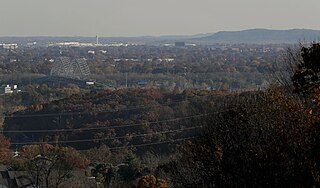
Floyd County is a county located in the U.S. state of Indiana. Its county seat is New Albany. The population of the county was 80,484 as of the 2020 United States Census. Floyd County has the second-smallest land area in the entire state. It was formed in the year 1819 from neighboring Clark and Harrison counties.

Jeffersonville is a city and the county seat of Clark County, Indiana, United States, situated along the Ohio River. Locally, the city is often referred to by the abbreviated name Jeff. It lies directly across the Ohio River to the north of Louisville, Kentucky, along I-65. The population was 49,447 at the 2020 census.
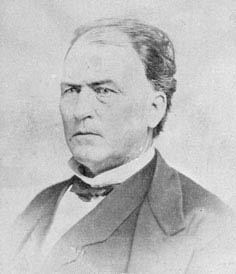
Jesse David Bright was the ninth Lieutenant Governor of Indiana and U.S. Senator from Indiana who served as President pro tempore of the Senate on three occasions. He was the only senator from a Northern state to be expelled for being a Confederate sympathizer. As a leading Copperhead he opposed the Civil War. He was frequently in competition with Governor Joseph A. Wright, the leader of the state's Republican Party.

The Clark–Chalker House is a historic home in the Middleburg Historic District in Middleburg, Florida, located at 3891 Main Street. On October 5, 1988, it was added to the U.S. National Register of Historic Places.

The Corydon Historic District is a national historic district located in Corydon, Indiana, United States. The town of Corydon is also known as Indiana's First State Capital and as Historic Corydon. The district was added to the National Register of Historic Places in 1973, but the listing was amended in 1988 to expand the district's geographical boundaries and include additional sites. The district includes numerous historical structures, most notably the Old Capitol, the Old Treasury Building, Governor Hendricks' Headquarters, the Constitution Elm Memorial, the Posey House, the Kintner-McGrain House, and The Kintner House Inn, as well as other residential and commercial sites.

Canaan is an unincorporated community and census-designated place (CDP) in Shelby Township, Jefferson County, Indiana, United States. As of the 2010 census it had a population of 90.
Masonic College was a higher education institution in Missouri that was established by Freemasons in 1844 and operated until 1857.

Camp Joe Holt was a Union base during the American Civil War in Jeffersonville, Indiana, across the Ohio River from Louisville, Kentucky, on land that is now part of Clarksville, Indiana, near the Big Eddy. It was a major staging area for troops in the Western Theatre of the War, in preparation for invading the Confederate States of America. Its establishment was the first major step performed by Kentucky Unionists to keep Kentucky from seceding to the Confederacy.

Indiana, a state in the Midwest, played an important role in supporting the Union during the American Civil War. Despite anti-war activity within the state, and southern Indiana's ancestral ties to the South, Indiana was a strong supporter of the Union. Indiana contributed approximately 210,000 Union soldiers, sailors, and marines. Indiana's soldiers served in 308 military engagements during the war; the majority of them in the western theater, between the Mississippi River and the Appalachian Mountains. Indiana's war-related deaths reached 25,028. Its state government provided funds to purchase equipment, food, and supplies for troops in the field. Indiana, an agriculturally rich state containing the fifth-highest population in the Union, was critical to the North's success due to its geographical location, large population, and agricultural production. Indiana residents, also known as Hoosiers, supplied the Union with manpower for the war effort, a railroad network and access to the Ohio River and the Great Lakes, and agricultural products such as grain and livestock. The state experienced two minor raids by Confederate forces, and one major raid in 1863, which caused a brief panic in southern portions of the state and its capital city, Indianapolis.
Lancaster is an unincorporated community in Lancaster Township, Jefferson County, Indiana.
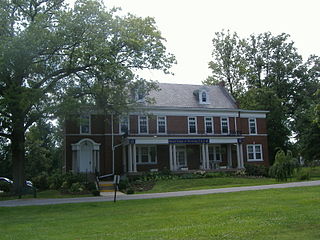
The Grand Lodge of Kentucky is one of two state organizations that supervise Masonic lodges in the state of Kentucky. It was established in 1800.

The Masonic Widows and Orphans Home, located in Louisville near St. Matthews, Kentucky, is a historic building on the National Register of Historic Places. It was built by the Grand Lodge of Kentucky to support the widows and orphans of Master Masons, but now is open to all senior citizens.

The Madison Historic District is a historic district located in Madison, Indiana. In 2006, it was named a National Historic Landmark due to its unique Midwestern beauty and architecture scheme. Among the prominent buildings in the district are the Lanier Mansion, one of two buildings separately considered a National Historic Landmark in the district, and the Schofield House, the birthplace of the Grand Lodge of Indiana. In total, it comprises 133 blocks of Madison, Indiana, overlooking the Ohio River in Jefferson County, Indiana.
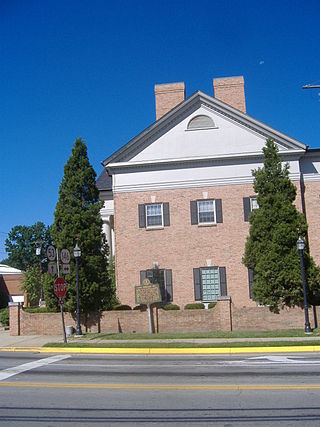
The Masonic University was an educational facility operated by the Grand Lodge of Kentucky in La Grange, Kentucky, located twenty miles northeast of Louisville, in the mid-nineteenth century. Among its faculty was Kentucky Chief Jurist and Confederate spy Thomas Hines, and Robert Morris, the poet laureate of Freemasonry.
A Mississippi Landmark is a building officially nominated by the Mississippi Department of Archives and History and approved by each county's chancery clerk. The Mississippi Landmark designation is the highest form of recognition bestowed on properties by the state of Mississippi, and designated properties are protected from changes that may alter the property's historic character. Currently there are 890 designated landmarks in the state. Mississippi Landmarks are spread out between eighty-one of Mississippi's eighty-two counties; only Issaquena County has no such landmarks.

The Joseph T. Smitherman Historic Building, also known by a variety of other names throughout its history, is a historic Greek Revival building in Selma, Alabama. Completed in 1847, it has served many functions in the more than 160 years of its existence. The building was added to the National Register of Historic Places on June 20, 1975, due to its architectural and historical significance. It currently houses the Vaughan-Smitherman Museum, a museum depicting Selma's history.
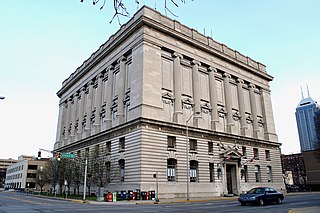
The current Indianapolis Masonic Temple, also known as Indiana Freemasons Hall, is a historic Masonic Temple located at Indianapolis, Indiana. Construction was begun in 1908, and the building was dedicated in May 1909. It is an eight-story, Classical Revival style cubic form building faced in Indiana limestone. The building features rows of engaged Ionic order columns. It was jointly financed by the Indianapolis Masonic Temple Association and the Grand Lodge of Free and Accepted Masons of Indiana, and was designed by the distinguished Indianapolis architectural firm of Rubush and Hunter.

The United States Capitol cornerstone laying was the Freemasonry ceremonial placement of the cornerstone of the United States Capitol on September 18, 1793. The cornerstone was laid by president of the United States George Washington Leder of the Lodge of the Continental Army, assisted by the Grand Master of Maryland Joseph Clark, in a Masonic ritual.

Jephtha Masonic Lodge No. 494 is an historic Masonic lodge, part of the fraternal organization of Freemasonry, located in Huntington, New York, part of the Suffolk Masonic District in Eastern, Long Island. It was established in late 1859.




















